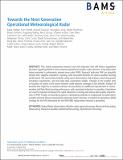| dc.contributor.author | Weber, Mark | |
| dc.contributor.author | Hondl, Kurt | |
| dc.contributor.author | Yussouf, Nusrat | |
| dc.contributor.author | Jung, Youngsun | |
| dc.contributor.author | Stratman, Derek | |
| dc.contributor.author | Putnam, Bryan | |
| dc.contributor.author | Wang, Xuguang | |
| dc.contributor.author | Schuur, Terry | |
| dc.contributor.author | Kuster, Charles | |
| dc.contributor.author | Wen, Yixin | |
| dc.contributor.author | Sun, Juanzhen | |
| dc.contributor.author | Keeler, Jeff | |
| dc.contributor.author | Ying, Zhuming | |
| dc.contributor.author | Cho, John | |
| dc.contributor.author | Kurdzo, James | |
| dc.contributor.author | Torres, Sebastian | |
| dc.contributor.author | Curtis, Chris | |
| dc.contributor.author | Schvartzman, David | |
| dc.contributor.author | Boettcher, Jami | |
| dc.contributor.author | Nai, Feng | |
| dc.contributor.author | Thomas, Henry | |
| dc.contributor.author | Zrnić, Dusan | |
| dc.contributor.author | Ivić, Igor | |
| dc.contributor.author | Mirković, Djordje | |
| dc.contributor.author | Fulton, Caleb | |
| dc.contributor.author | Salazar, Jorge | |
| dc.contributor.author | Zhang, Guifu | |
| dc.contributor.author | Palmer, Robert | |
| dc.contributor.author | Yeary, Mark | |
| dc.contributor.author | Cooley, Kevin | |
| dc.contributor.author | Istok, Michael | |
| dc.contributor.author | Vincent, Mark | |
| dc.date.accessioned | 2022-04-14T12:52:50Z | |
| dc.date.available | 2022-04-14T12:52:50Z | |
| dc.date.issued | 2021-07 | |
| dc.identifier.issn | 0003-0007 | |
| dc.identifier.issn | 1520-0477 | |
| dc.identifier.uri | https://hdl.handle.net/1721.1/141901 | |
| dc.description.abstract | <jats:title>Abstract</jats:title><jats:p>This article summarizes research and risk reduction that will inform acquisition decisions regarding NOAA’s future national operational weather radar network. A key alternative being evaluated is polarimetric phased-array radar (PAR). Research indicates PAR can plausibly achieve fast, adaptive volumetric scanning, with associated benefits for severe-weather warning performance. We assess these benefits using storm observations and analyses, observing system simulation experiments, and real radar-data assimilation studies. Changes in the number and/or locations of radars in the future network could improve coverage at low altitude. Analysis of benefits that might be so realized indicates the possibility for additional improvement in severe-weather and flash-flood warning performance, with associated reduction in casualties. Simulations are used to evaluate techniques for rapid volumetric scanning and assess data quality characteristics of PAR. Finally, we describe progress in developing methods to compensate for polarimetric variable estimate biases introduced by electronic beam-steering. A research-to-operations (R2O) strategy for the PAR alternative for the WSR-88D replacement network is presented.</jats:p> | en_US |
| dc.description.sponsorship | National Ocean and Atmospheric Administration (NOAA) | en_US |
| dc.publisher | American Meteorological Society | en_US |
| dc.relation.isversionof | 10.1175/bams-d-20-0067.1 | en_US |
| dc.rights | Article is made available in accordance with the publisher's policy and may be subject to US copyright law. Please refer to the publisher's site for terms of use. | en_US |
| dc.source | John Y. N. Cho | en_US |
| dc.subject | Atmospheric Science | en_US |
| dc.title | Towards the Next Generation Operational Meteorological Radar | en_US |
| dc.type | Article | en_US |
| dc.identifier.citation | Weber, Mark, Hondl, Kurt, Yussouf, Nusrat, Jung, Youngsun, Stratman, Derek et al. 2021. "Towards the Next Generation Operational Meteorological Radar." Bulletin of the American Meteorological Society, 102 (7). | |
| dc.contributor.department | Lincoln Laboratory | |
| dc.contributor.department | Lincoln Laboratory | |
| dc.relation.journal | Bulletin of the American Meteorological Society | en_US |
| dc.eprint.version | Final published version | en_US |
| dc.type.uri | http://purl.org/eprint/type/JournalArticle | en_US |
| eprint.status | http://purl.org/eprint/status/PeerReviewed | en_US |
| dc.identifier.doi | 10.1175/BAMS-D-20-0067.1 | |
| dspace.date.submission | 2022-04-13T19:02:46Z | |
| mit.journal.volume | 102 | en_US |
| mit.journal.issue | 7 | en_US |
| mit.license | PUBLISHER_POLICY | |
| mit.metadata.status | Authority Work and Publication Information Needed | en_US |
